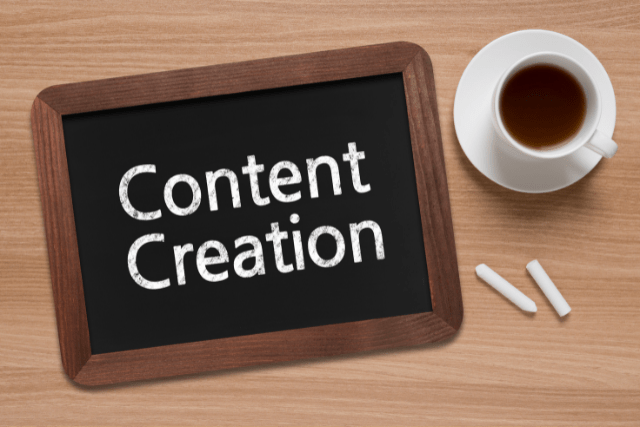Mastering the art of content creation is essential for businesses and individuals today. This comprehensive guide will delve into crafting compelling copy and visuals that captivate your audience while driving results.
Whether you’re a blogger, entrepreneur, or online business owner looking to enhance your marketing efforts, our expert tips will take your content strategy to new heights.
Table of Contents
Key Takeaways
- Content creation produces valuable and engaging material tailored to your target audience that attracts new customers, nurtures existing relationships, and builds trust and authority in your industry while providing value to your readers or viewers.
- Crafting compelling copy requires developing clear and concise messages using storytelling techniques, incorporating SEO keywords, applying readability principles, and capturing attention by crafting captivating headlines and intros.
- Mastering visual content entails choosing visuals consistent with your brand tone and messaging, creating infographics for complex information presentations, and incorporating videos/animations/interactive elements to engage audiences effectively, following design principles like balance/proportion/contrast while ensuring accessibility for all users.
- Effective content creation demands ongoing analysis and optimization based on insights gained through continuous review of engagement metrics – building a successful online presence is no longer an option but a necessity in today’s digital landscape!
The Fundamentals Of Content Creation
Define content creation and its purpose, understand your target audience, and identify different types of content to create engaging content optimized for SEO effectively.
Defining Content Creation And Its Purpose
Content creation produces engaging, informative, and valuable material tailored for your target audience to attract new customers and nurture existing relationships.
This can include various formats such as blog posts, articles, videos, infographics, social media updates, podcasts, and more.
For online business owners and entrepreneurs, quality content helps drive website traffic through search engine optimization (SEO), enhances brand visibility across digital channels, and fosters customer engagement by effectively addressing their interests and needs.
For example, a fitness blogger sharing workout routines may attract health-conscious individuals seeking guidance on exercise techniques. Over time, these valuable pieces of content help build trust within their niche community while promoting brand recognition that can boost lead generation and even sales conversions.

Understanding Your Target Audience And The Importance Of SEO
To create successful content, it is essential to understand your target audience and the importance of Search Engine Optimization (SEO). Identifying your target audience helps you build a strong connection by creating content that resonates with their interests and needs.
Researching your target audience’s demographics, psychographics, behaviours, and preferences for consuming digital content is crucial.
Additionally, SEO optimization allows for better visibility on search engines like Google, Yahoo!, and Bing – helping potential customers find your website organically.
Therefore, crafting exceptional copy is only one aspect of excellent content creation; understanding the importance of SEO optimization while considering the target audience’s needs is vital for creating valuable pieces that resonate with them while maximizing reach.
Identifying Different Types Of Content
One key aspect of mastering content creation is understanding the different types of content that can be created to engage your audience. Here are some of the different content types to consider:
- Blog posts: written articles sharing insights, news, and updates relevant to your target audience.
- Infographics: visually compelling graphics that present information in a way that’s easy to understand.
- Social media posts: short and engaging messages shared on specific social media platforms like Twitter or Instagram.
- Videos: Create a more personal connection with your audience by providing visual stimulation and audio accompaniment.
- Podcasts: similar to video but audio-based, bringing people together through informative talks and interviews.
- Whitepapers/eBooks: lengthy documents that provide detailed information on a particular subject, useful for gaining leads.
- Webinars are live events that bring experts together for online discussions and knowledge-sharing sessions.
Identifying the type of content you want to create makes it easier to produce relevant and engaging messages for your audience. Don’t forget to include targeted keywords in your copy so search engines can find it easily!
Crafting Compelling Written Content
Craft compelling written content by developing a clear and concise message, incorporating storytelling techniques, applying SEO keywords, and ensuring readability and accessibility.
Crafting Captivating Headlines And Intros
Crafting captivating headlines and intros is a crucial part of content creation. Your headline is the first thing your audience will see and needs to capture their attention immediately.
A great headline should be clear, concise, and benefit-driven.
Introductions are equally important; they help set the tone for your piece and encourage readers to keep reading. An engaging introduction piques curiosity by using storytelling techniques or asking thought-provoking questions that make readers want to learn more about what you have to say.
Developing A Clear And Concise Message
Crafting a clear and concise message is crucial for effective content creation. Your audience should be able to understand your message without confusion or ambiguity.
To achieve this, start by identifying the key points you want to communicate and organizing them into a logical order.
Use bullet points, lists, or subheadings to break up text and make it more digestible. Additionally, focus on providing value to the reader with your content rather than simply promoting your brand or products.
For example; if you’re creating content around natural skincare routines for middle-aged women, instead of simply promoting your line of beauty products; offer tips on lifestyle habits that contribute directly towards healthy skin care, such as eating a balanced diet and staying hydrated every day, etc., while also subtly suggesting the use of certain products like sunscreen lotions, etc.
Applying Storytelling Techniques
One of the most effective ways to create compelling content is by incorporating storytelling techniques. By weaving an engaging narrative, you can connect with your audience on a deeper level and keep them interested in what you have to say.
To apply storytelling techniques effectively, start by identifying the main message or idea you want to convey.
For example, if you’re creating content for a health and wellness website, consider telling a personal anecdote about how changing your diet helped improve your overall well-being.
Or, if you run a business focused on sustainability, share stories about real people who have made meaningful changes in their lives to reduce their environmental impact.
Incorporating SEO Keywords
Including SEO keywords in your content is crucial for making it discoverable on search engines. These keywords are words and phrases people use to search for information online.
By incorporating them strategically into your content, you increase the chances of your website or blog ranking higher in search results.
For instance, if you were creating content about healthy eating, some relevant SEO keywords could be “best foods for weight loss,” “healthy meal ideas,” or “nutritious snacks.” Incorporating these terms throughout the text can improve its relevance and visibility for those searching for such topics.
Using keyword research tools like Google Keyword Planner can help identify suitable terms related to your subject matter and ensure that they match what people are searching for online.

Ensuring Readability And Accessibility
One key element of effective content creation is ensuring that your written copy is accessible and easy to read for all users. This means using a clean and simple design, with plenty of white space and clear headings to break up the text.
It also means writing in short sentences, avoiding complex jargon or technical terms, and using bullet points or numbered lists where appropriate.
For example, if you’re creating website copy for a new product launch, use short paragraphs highlighting key benefits in an easy-to-read format.
Mastering Visual Content
Incorporate the right visual content for your message, use design principles and colour theory, utilize multimedia elements, and ensure accessibility for all users.
Incorporating The Right Type Of Visual Content For Your Message
Visual content is an essential component of any successful content creation strategy. The right visuals can enhance the impact of your message and help you connect with your audience. Here are some tips to help you incorporate the right type of visual content for your message:
- Use images that align with your brand: Choose visuals consistent with your brand’s tone and message.
- Include infographics: Infographics are a great way to present complex information in an easily digestible format.
- Utilize multimedia elements: Incorporate videos, animations, and interactive elements to engage your audience and add variety to your content.
- Follow design principles and color theory: Use balance, proportion, and contrast to create visually appealing content that captures attention.
- Ensure accessibility for all users: Make sure your visuals are accessible to all users, including those with disabilities.
By incorporating these tips into your visual content strategy, you can create more engaging and impactful content that resonates with your audience while staying true to your brand’s messaging.
Using Design Principles And Color Theory
Mastering the art of content creation involves more than just writing compelling copy. Visual elements are equally important in capturing your audience’s attention and conveying your message effectively.
Design principles and colour theory are vital in creating visuals that complement your written content.
Incorporating design elements like typography, layout, and white space can make your visual content more appealing to readers. Similarly, using colour psychology and understanding the effect of colours on emotions can help you create a mood or evoke specific feelings in your audience.
By utilizing design principles and colour theory when crafting visual content for websites or social media platforms like Facebook, entrepreneurs can enhance their brand’s identity and improve engagement with potential customers.
Utilizing Multimedia Elements
Incorporating multimedia elements into your content can take it to the next level. Whether you’re creating blog posts, social media updates, or website copy, incorporating images, videos, and infographics can help convey your message more effectively.
For instance, including an eye-catching video clip that showcases your brand’s story can be a powerful tool for getting people interested in what you have to offer.
Instead of just displaying images of products, many e-commerce platforms are now incorporating video demonstrations. These videos offer potential buyers a better sense of the product, from its size to functionality, enhancing the likelihood of purchase.
Multimedia Tools and Software
- Image editing tools: Software like Adobe Photoshop and GIMP allow users to create, edit, and manipulate images for use in multimedia projects.
- Video editing tools: Programs like Adobe Premiere and Final Cut Pro enable users to edit and produce video content with effects, transitions, and more.
- Audio editing tools: Applications like Audacity and Adobe Audition allow users to record, edit, and mix audio content for multimedia projects.
- Animation tools: Software like Adobe Animate and Blender allow users to create animations for use in videos, interactive content, or as standalone elements.
- Interactive content creation tools: Programs such as Articulate Storyline and Adobe Captivate enable users to create interactive multimedia content, including e-learning courses, quizzes, and simulations.
Similarly, infographics are a great way to explain complex ideas in an easily understandable format. When utilizing multimedia elements in your content creation efforts, remember to keep accessibility at the forefront of your mind by including alt tags and captions wherever necessary.
Ensuring Accessibility For All Users
In today’s digital age, accessibility is a must for any content creator. It means ensuring everybody can consume your content, regardless of their abilities or limitations.
When creating visual content, using descriptive captions and alternative text for images is important so that individuals with visual impairments can still engage with your message.
Furthermore, optimizing your website design to comply with the Web Content Accessibility Guidelines (WCAG) helps you reach a wider audience while offering a better overall user experience.
This includes incorporating features such as audio descriptions or subtitles in videos and providing larger font sizes and high-contrast options for those who have trouble reading small print.
Promoting And Distributing Your Content
Identify the right channels for distribution and develop a promotion strategy that aligns with your goals, including social media sharing and email marketing.
Identifying The Right Channels For Your Content
To ensure maximum reach and engagement, it is crucial to identify the right channels for distributing your content. Here are some key channels to consider when promoting your content:
- Social Media: Utilize social media platforms like Facebook, Twitter, LinkedIn, and Instagram to share your content and engage with your audience.
- Email Marketing: Build an email list to share your latest blog posts, newsletters, and promotions.
- Guest Blogging: Collaborate with other bloggers or websites in your niche to guest post on their sites and gain exposure for your brand.
- Influencer Marketing: Partner with influencers who align with your brand values to promote your content and drive traffic to your site.
- Paid Advertising: Use paid advertising platforms like Google AdWords or Facebook Ads to target specific audiences and increase visibility for your content.
Remember that the success of each channel can depend on factors like audience demographics, industry trends, and individual preferences. Analyze metrics like click-through rates and engagement levels to determine which channels are most effective for promoting your content.

Developing A Distribution And Promotion Strategy
Once you have created compelling content, the next step is promoting it and effectively reaching your target audience. Developing a distribution and promotion strategy requires identifying the right channels for your content and leveraging them to attract potential leads.
Consider your audience’s preferences and behaviour patterns to create an effective strategy.
Another important aspect of promoting your content is identifying influencers in your industry who can help amplify its reach.
A successful distribution and promotion strategy requires consistency and commitment to regularly share high-quality content with relevant audiences across different channels.
Sharing On Social Media And Utilizing Email Marketing
One of the key aspects of successful content creation is promoting and distributing your content effectively. Here are some tips for sharing on social media and utilizing email marketing:
- Identify the right channels for your content. Different types of content will perform better on different platforms, so it’s important to consider where your audience is most active.
- Develop a distribution and promotion strategy. This should include a timeline for posting your content and any unique tactics or campaigns you plan to use.
- Share on social media regularly. For bloggers, online business owners, entrepreneurs, and businessmen alike, social media can be a powerful tool for building an audience and driving traffic to your website. Consistency is key – schedule regular posts across multiple platforms to stay top-of-mind with your followers.
- Utilize email marketing campaigns to reach out directly to potential customers who have opted in to hear from you. Personalization, automation, and segmentation can all help improve the effectiveness of these campaigns.
- Keep track of engagement metrics like likes, shares, and comments to optimize future promotion strategies.
Effective content promotion is as important as crafting high-quality copy and visuals!
Analyzing And Measuring Success
Track your progress and optimize future content creation efforts! Learn how by reading our comprehensive guide to crafting compelling copy and visuals for successful content marketing.
Identifying Key Metrics And Tools
As a content creator, it’s essential to identify key metrics and tools that can help you measure the success of your content. Here are some important metrics and tools to consider:
- Traffic sources: Analyzing your traffic sources can help you determine where your audience is coming from and which channels drive the most traffic to your website or blog.
- Engagement metrics: Measuring engagement metrics like time on page, bounce rate, and social media shares can help you determine how well your content resonates with your audience.
- Conversion rates: Keeping track of conversion rates will let you see how many website visitors take action after viewing your content, such as filling out a form or purchasing.
- Google Analytics: This free tool allows you to analyze website traffic data, audience demographics, and behaviour patterns for all pages on your site.
- SEMRush: SEMRush is an SEO tool that enables you to track rankings and keywords, perform competitor analysis, and optimize your content for search engines.
- Ahrefs: Ahrefs is another powerful SEO tool that provides insights into backlinks, keyword rankings, and organic search traffic.
- Buzzsumo: Buzzsumo is a content research tool that enables you to find popular topics in any industry and identify influential social media users who can promote your content.
By identifying these key metrics and using relevant tools like Google Analytics, SEMRush, Ahrefs, and Buzzsumo, you can better understand the effectiveness of your content marketing strategy and make informed decisions about future content creation efforts.
Using Insights To Optimize Future Content Creation
After creating content, it’s crucial to analyze its success and identify areas for improvement. This is where insights come in. Using tools like Google Analytics and social media metrics lets you learn which pieces of content perform well, which topics your audience resonates with the most, and how they engage with your website.
Armed with these insights, you can optimize future content creation efforts by tailoring your strategy to better align with what has worked in the past. For example, if you find that videos have a higher engagement rate than blog posts on Facebook, it would make sense to focus more on video content moving forward.
By constantly analyzing data and adjusting strategies based on insights gained from that data, bloggers and online business owners can increase their chances of continued success in their respective industries.
Conclusion
In today’s digital landscape, creating high-quality content is no longer just an option; it’s necessary. With the help of EcomWeaver, you can learn to access all the tools, techniques, and strategies you need to stay ahead of the curve.
Engagement is key, so focus on providing value while being concise with your messaging. Don’t forget that visuals are just as important as written copy! Incorporate design principles and multimedia elements for maximum impact.
Above all else, remember that effective content creation requires ongoing analysis and optimization.
Frequently Asked Questions:
What are the key elements of compelling content creation?
Compelling content is created through effective copywriting and visually engaging design. It begins with understanding the target audience, identifying their needs and interests, and crafting messages that resonate with them. Incorporating persuasive language, storytelling techniques, and calls to action can help engage readers further.
How do I choose the right visual content for my marketing materials?
Choosing the right visual content requires considering budget, message, audience preferences, and brand identity. High-quality images or videos that effectively convey your message while aligning with your brand’s style will be most impactful.
Can I improve my writing skills to create a more compelling copy?
Yes! Effective copywriting involves strategic planning around messaging communicated through concise yet powerful messaging across all mediums (e.g., print ads, social media posts, landing pages, etc). To improve your writing abilities, consider taking courses building proficiency in grammar & syntax, researching industry trends & competition, and working alongside experienced writers who can provide feedback on technique, tone, voice, clarity, sentence structure pacing making sure ideas expressed come across clearly without being overly repetitive nor difficult understand.
What does it mean to optimize my content for search engines?
To improve content for search engines, ensure keywords are relevant to terms, related phrases frequently used by users searching queries, and appear close to each other. This helps algorithms rank higher in SERPs based on relevancy, user intent, authority, credibility, website or blog authorship, quality links (outbound, internal), and other signals of trustworthiness, usefulness, and overall visitor experience.







